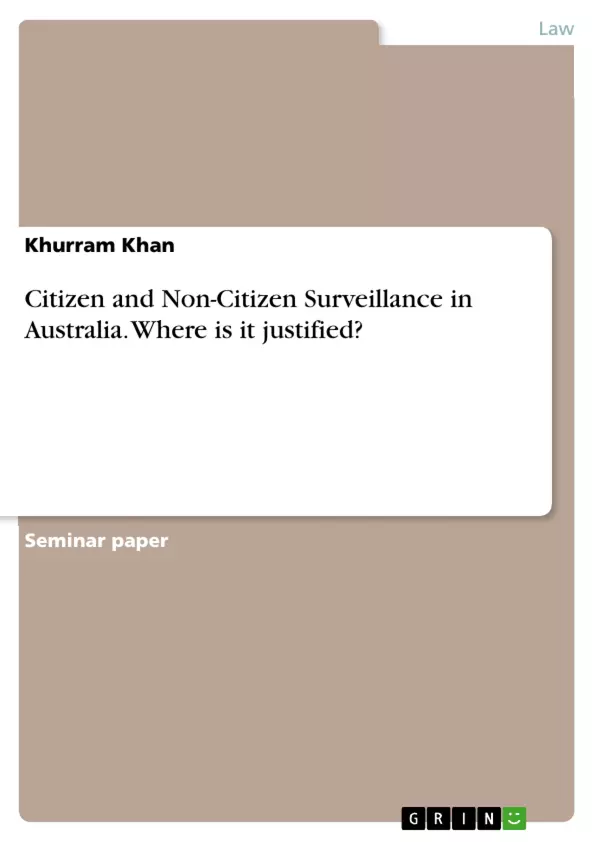Government surveillance is turning out to be a great interference into privacy not only of non-citizens, but also of citizens. The primary argument is the basic legal standard, which should be applied on the two specific cohorts (i.e. citizens and non-citizens), to rationalize the major state duties and rights of residents.
This reflective essay discusses successively diverse, significant factors that create an understanding of the policies and regulations concerning the national surveillance policy of Australia.
The subject would be explained through description and core analysis of; government responsibilities in the light of liberty, protection and trust to shape policies; identification of privacy as a fundamental human right; use of technology as a tool for surveillance; surveillance of citizens as potential suspects; surveillance of non citizens in threat of shipped terrorism; and future aspects of changing levels of monitoring. Finally, in the conclusion, the laid arguments and examples would lead the subject to identify the basic legal standards, which should be applied to government’s surveillance of their citizens and their non-citizens.
Inhaltsverzeichnis (Table of Contents)
- Introduction
- Responsibilities of Government
- Liberty
- Protection
- Trust
- Privacy: A fundamental human right
- Technology: A tool for surveillance
- Internet
- Other technologies
- Citizen Surveillance
- Citizen: a suspect
- Citizens not suspect
- Non-Citizen Surveillance
- Non-citizen: shipped terrorism
- Future aspects of changing levels of monitoring
- Australia, Privacy and Surveillance
Zielsetzung und Themenschwerpunkte (Objectives and Key Themes)
This essay aims to analyze the legal standards that should be applied to government surveillance of citizens and non-citizens in Australia. It explores the complex relationship between privacy rights, national security, and the responsibilities of government.
- The responsibilities of government in balancing liberty, protection, and trust
- Privacy as a fundamental human right, and the challenges it faces in the context of surveillance
- The use of technology as a tool for surveillance, and the potential implications for privacy
- The ethical and legal considerations surrounding the surveillance of citizens and non-citizens
- The future challenges of balancing privacy with security in an increasingly interconnected world
Zusammenfassung der Kapitel (Chapter Summaries)
The introduction provides an overview of the essay's scope, outlining its focus on government surveillance in Australia and the diverse factors that contribute to its complexities. Chapter 2 examines the responsibilities of government in balancing its obligations to its citizens, including safeguarding liberty, protecting from threats, and fostering trust.
Chapter 3 delves into the concept of privacy as a fundamental human right and its legal framework in Australia, while also exploring the potential for government intervention in the name of public interest. Chapter 4 examines the role of technology in modern surveillance, highlighting the use of both traditional methods like CCTV and emerging technologies like internet platforms.
Chapter 5 focuses on the surveillance of citizens, exploring the arguments for and against such practices and examining the potential impact on individual freedoms and trust in government. Chapter 6 delves into the specific challenges presented by the surveillance of non-citizens, particularly in relation to potential threats of terrorism.
Chapter 7 explores the future implications of government surveillance, considering the potential consequences of both increased and reduced levels of monitoring. Finally, Chapter 8 examines the specific context of Australia in relation to privacy and surveillance, highlighting the country's unique challenges and the need for balanced and transparent practices.
Schlüsselwörter (Keywords)
This essay focuses on the key themes of government surveillance, privacy rights, national security, liberty, trust, and technology. It explores the legal and ethical considerations surrounding the surveillance of citizens and non-citizens, particularly in the context of counter-terrorism efforts and the ongoing debate about the balance between individual freedoms and public safety. The essay also considers the challenges of navigating these complexities in an increasingly interconnected world, where technology plays a significant role in both facilitating and challenging privacy.
- Quote paper
- Khurram Khan (Author), 2015, Citizen and Non-Citizen Surveillance in Australia. Where is it justified?, Munich, GRIN Verlag, https://www.grin.com/document/353879



